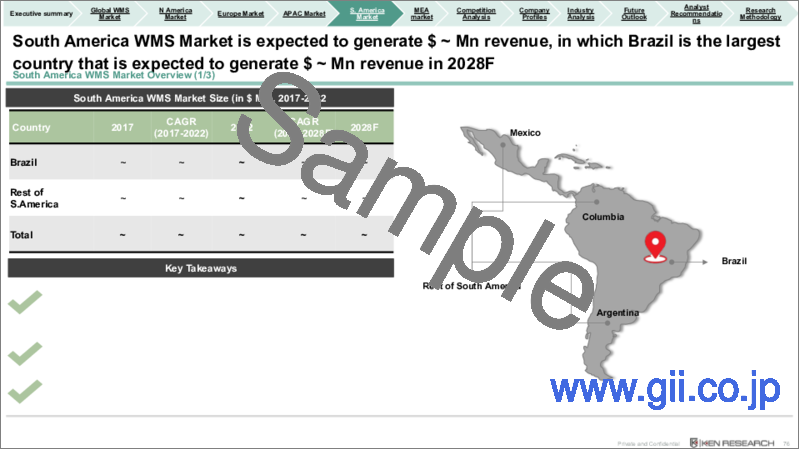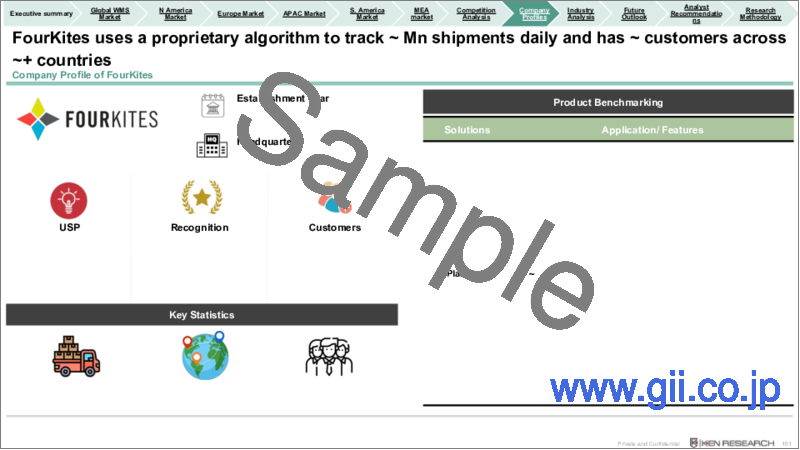|
|
市場調査レポート
商品コード
1257303
WMS (倉庫管理システム) の世界市場の展望:2028年Global WMS Market Outlook to 2028 |
||||||
| WMS (倉庫管理システム) の世界市場の展望:2028年 |
|
出版日: 2023年03月18日
発行: Ken Research Private Limited
ページ情報: 英文
納期: 即日から翌営業日
|
- 全表示
- 概要
- 目次
世界のWMS (倉庫管理システム) の市場規模は、2017年から2022年にかけてCAGR13.0%の成長を示しました。同市場では、自動化プロセスと手動プロセスの統合、eコマースの拡大、オムニチャネルフルフィルメント、物流コストの軽減、クラウドベースシステムへの移行が急速に進んでいます。さらに、2022年から2028年にかけては、15.2%のCAGRで成長すると予測されています。
当レポートでは、世界のWMS (倉庫管理システム) の市場を調査し、市場概要、市場成長への各種影響因子の分析、技術動向、市場規模の推移・予測、各種区分・地域別の詳細分析、競合環境、主要企業のプロファイルなどをまとめています。
目次
第1章 エグゼクティブサマリー
第2章 世界のWMS市場の規模・各種部門別:2017-2022年
- 世界のWMSのエコシステム
- 世界のWMS市場のバリューチェーン
- 世界のWMSシステム管理市場の推移
- 世界のWMSシステム管理市場:コンポーネント別
- 世界のWMSシステム管理市場:展開別
- 世界のWMSシステム管理市場:用途別
- 世界のWMSシステム管理市場:機能別
- 世界のWMSシステム管理市場:地域別
- 地域市場・促進要因
- 地域市場:機能別
- 地域市場:用途別
- 地域市場:機能別
第3章 北米のWMS市場
- 市場概要
- 米国
- カナダ
- メキシコ
- コンポーネント・展開別
- 用途別
- 機能別
第4章 欧州のWMS市場
- 市場概要
- 英国
- ドイツ
- フランス
- コンポーネント・展開別
- 用途別
- 機能別
第5章 アジア太平洋のWMS市場
- 市場概要
- 中国
- インド
- 日本
- コンポーネント・展開別
- 用途別
- 機能別
第6章 南米のWMS市場
- 市場概要
- ブラジル
- コンポーネント・展開別
- 用途別
- 機能別
第7章 中東・アフリカのWMS市場
- 市場概要
第8章 WMS市場の競合分析
- Gartner Magic Quadrant
- ベンダー情勢
- 主要WMSプロバイダーの相互比較
- 競合ダッシュボード分析
- 影響分析:最近のM&A
- 影響分析:最近の製品開発
- 影響分析:最近の提携・協力
第9章 WMS市場の主要企業プロファイル
- Blue Yonder
- Epicor
- Fishbowl
- Fourkites
- Highjump
- Infor
- Made4Net
- Manhattan Associates
- NICE
- Oracle
- Project 44
- PSI
- Reply
- SAP
- Softeon
- Synergy
- Tecsys
第10章 WMS市場の産業分析
- 普及・成長の見通しマッピング
- エンドユーザー分析
- ポーターのファイブフォース分析
- PEST分析
- 市場促進要因
- 市場力学
- 技術動向・開発
- 市場課題
- COVID-19の影響
第11章 WMS市場の将来の見通し・予測
- 市場規模
- 市場規模:コンポーネント・展開別
- 市場規模:用途別
- 市場規模:機能別
- 地域市場
- 地域市場の将来の促進要因
- 地域市場:機能別
- 地域市場:用途別
- 地域市場:機能別
第12章 アナリストによる提言
- 世界の倉庫業の発展段階
- 主要エンドユーザー産業全体の新たな動向
- WMSで必要なサービス
- 理想的な従業員構成とITによる付加的なロジスティクス
- WMSプロバイダーの提携
第13章 調査手法
The report provides a comprehensive analysis of the potential of the Warehousing Management System Industry globally. The report covers an overview and genesis of the industry, and market size in terms of revenue generated.
Its market segmentations include By Component, By Deployment, By Application, and By Function; growth enablers and drivers; challenges and bottlenecks; trends and developments; regulatory framework; porter's five forces, industry analysis, competitive landscape including company profile and market shares of global players. The report concludes with future market projections of each market segmentation and analyst recommendations.
Market Overview:
According to Ken Research estimates, the Global WMS Market expanded at a CAGR of 13.0% between 2017 and 2022 on the basis of revenue generated. The market saw a rapid increase in integration between automated & manual processes, expansion of E-commerce, and omnichannel fulfillment, mitigation of distribution costs, and transition towards Cloud-based Systems. The Global WMS Market is estimated to grow at a positive CAGR of 15.2% between 2022 and 2028.
The cloud segment holds the highest revenue share in 2022, emerging as the fastest-growing segment, owing to the Cloud-based technology that has been revolutionizing the way business functions.
In developing economies such as India, Europe, Africa and more, introduction of GST has enabled companies to focus on building larger warehouses.
The healthcare segment is anticipated to emerge as a prominent adopter of WMS, as providers are building facilities taking into consideration the pre-requisites of the healthcare sector.
Key Trends by Market Segments:
- By Component: The services segment includes consulting, system integration, operation, and maintenance services. Warehouse management can be provided as a service by third-party vendors, which is outsourced by WMS providers. Moreover, growth can be attributed to the increasing adoption of WMS software worldwide. Vendors sell their products by either offering them as a service, which helps the clients to focus on their core business operations, or by selling the software to the client without the service.
- By Deployment: Over the years, cloud deployment has become as secure as the on-premise system on account of data sovereignty and the successful curbing of data thefts. Companies are now customizing and providing a WMS service based on the client's requirements. The on-premise deployment has been prominent since the advent of WMS and is characterized by huge servers and high maintenance costs, ultimately increasing the company's expenditures. These upfront costs and ownership of maintaining the on-premise server are incredibly high compared to the cloud-based technology.
Competitive Landscape:
Future Outlook
The Global WMS Market is projected to show significant growth in the coming years. It is expected to be driven by rising trend of e-commerce, expansion of warehouses coupled with technological advancements and favourable government policies. America being the second largest for e-commerce in the world have enabled the customers to create an immediate and real-time demand impact on the order fulfilment operations driving the demand for highly adaptive and scalable WMS. Moreover, Cloud adoption is helping businesses in the Middle East and Africa to cut overall operational costs, boost profitability and seamlessly address COVID-19-induced market disruptions. These reasons are further driving demand for WMS.
The warehouse of the future will take advantage of automated capacity management by leveraging technology for better, data-driven capacity planning. There by, system integration and maintenance will be demanded even by small and medium warehousing businesses where this segment is anticipated to grow in near future.
Additionally, the emergence of global technologies such as AI is transforming most organizations, including warehousing. Sustainable supply chains and their partners using the latest technologies will be key drivers for future growth.
Table Of Contents
1. Executive Summary
- 1.1 Executive Summary: Global WMS Market
2. Global WMS Market Size and Segmentation, 2017-2022
- 2.1 Ecosystem of Global Warehousing Management System
- 2.2 Value Chain of Global WMS Market
- 2.3 Market Sizing of Global WMS Systems Management, 2017-2022
- 2.4 Global WMS Systems Management Market Segmentation by Component, 2017 and 2022
- 2.5 Global WMS Systems Management Market Segmentation by Deployment, 2017 and 2022
- 2.6 Global WMS Systems Management Market Segmentation by Application, 2017 and 2022
- 2.7 Global WMS Systems Management Market Segmentation by Function, 2017 and 2022
- 2.8 WMS Systems Management Market by Region, 2022
- 2.9 Regional Market Growth Drivers
- 2.10 Regional Segmentation Split by Function, 2017 and 2022
- 2.11 Regional Segmentation Split by Application, 2017 and 2022
- 2.12 Regional Segmentation Split by Function, 2017 and 2022
3. Regional Analysis of North America WMS Market
- 3.1 North America WMS Market Overview
- 3.2 Market Sizing of US WMS Systems Management, 2017-2022
- 3.3 US WMS Systems Management Market Segmentation by Component and Deployment, 2017, 2022 and 2028F
- 3.4 US WMS Systems Management Market Segmentation by Application, 2017, 2022 and 2028F
- 3.5 US WMS Systems Management Market Segmentation by Function, 2017, 2022 and 2028F
- 3.6 Market Sizing of Canada WMS Systems Management, 2017-2022
- 3.7 Canada WMS Systems Management Market Segmentation by Component and Deployment, 2017, 2022 and 2028F
- 3.8 Canada WMS Systems Management Market Segmentation by Application, 2017, 2022 and 2028F
- 3.9 Canada WMS Systems Management Market Segmentation by Function, 2017, 2022 and 2028F
- 3.10 Market Sizing of Mexico WMS Systems Management, 2017-2022
- 3.11 Mexico WMS Systems Management Market Segmentation by Component and Deployment, 2017, 2022 and 2028F
- 3.12 Mexico WMS Systems Management Market Segmentation by Application, 2017, 2022 and 2028F
- 3.13 Mexico WMS Systems Management Market Segmentation by Function, 2017, 2022 and 2028F
4. Regional Analysis of Europe WMS Market
- 4.1 Europe WMS Market Overview
- 4.2 Market Sizing of UK WMS Systems Management, 2017-2022
- 4.3 UK WMS Systems Management Market Segmentation by Component and Deployment, 2017, 2022 and 2028F
- 4.4 UK WMS Systems Management Market Segmentation by Application, 2017, 2022 and 2028F
- 4.5 UK WMS Systems Management Market Segmentation by Function, 2017, 2022 and 2028F
- 4.6 Market Sizing of Germany WMS Systems Management, 2017-2022
- 4.7 Germany WMS Systems Management Market Segmentation by Component and Deployment, 2017, 2022 and
- 2028F
- 4.8 Germany WMS Systems Management Market Segmentation by Application, 2017, 2022 and 2028F
- 4.9 Germany WMS Systems Management Market Segmentation by Function, 2017, 2022 and 2028F
- 4.10 Market Sizing of France WMS Systems Management, 2017-2022
- 4.11 France WMS Systems Management Market Segmentation by Component and Deployment, 2017, 2022 and 2028F
- 4.12 France WMS Systems Management Market Segmentation by Application, 2017, 2022 and 2028F
- 4.13 France WMS Systems Management Market Segmentation by Function, 2017, 2022 and 2028F
5. Regional Analysis of Asia- Pacific WMS Market
- 5.1 Asia- Pacific WMS Market Overview
- 5.2 Market Sizing of China WMS Systems Management, 2017-2022
- 5.3 China WMS Systems Management Market Segmentation by Component and Deployment, 2017, 2022 and 2028F
- 5.4 China WMS Systems Management Market Segmentation by Application, 2017, 2022 and 2028F
- 5.5 China WMS Systems Management Market Segmentation by Function, 2017, 2022 and 2028F
- 5.6 Market Sizing of India WMS Systems Management, 2017-2022
- 5.7 India WMS Systems Management Market Segmentation by Component and Deployment, 2017, 2022 and 2028F
- 5.8 India WMS Systems Management Market Segmentation by Application, 2017, 2022 and 2028F
- 5.9 India WMS Systems Management Market Segmentation by Function, 2017, 2022 and 2028F
- 5.10 Market Sizing of Japan WMS Systems Management, 2017-2022
- 5.11 Japan WMS Systems Management Market Segmentation by Component and Deployment, 2017, 2022 and 2028F
- 5.12 Japan WMS Systems Management Market Segmentation by Application, 2017, 2022 and 2028F
- 5.13 Japan WMS Systems Management Market Segmentation by Function, 2017, 2022 and 2028F
6. Regional Analysis of South America WMS Market
- 6.1 South America WMS Market Overview
- 6.2 Market Sizing of Brazil WMS Systems Management, 2017-2022
- 6.3 Brazil WMS Systems Management Market Segmentation by Component and Deployment, 2017, 2022 and 2028F
- 6.4 Brazil WMS Systems Management Market Segmentation by Application, 2017, 2022 and 2028F
- 6.5 Brazil WMS Systems Management Market Segmentation by Function, 2017, 2022 and 2028F
7. Regional Analysis of MEA WMS Market
- 7.1 MEA WMS Market Overview
8. Competition Analysis of WMS Market
- 8.1 Gartner Magic Quadrant
- 8.2 Vendor Landscape
- 8.3 Cross Comparison of Major WMS providers
- 8.4 Competitive Dashboard Analysis
- 8.5 Impact Analysis of Recent Mergers and Acquisitions
- 8.6 Impact Analysis of Recent Product Development
- 8.7 Impact Analysis of Recent Partnership and Collaborations
9. Company Profiles of Major Players in WMS Market
- 9.1 Company Profile of Blue Yonder
- 9.2 Company Profile of Epicor
- 9.3 Company Profile of Fishbowl
- 9.4 Company Profile of Fourkites
- 9.5 Company Profile of Highjump
- 9.6 Company Profile of Infor
- 9.7 Company Profile of Made4Net
- 9.8 Company Profile of Manhattan Associates
- 9.9 Company Profile of NICE
- 9.10 Company Profile of Oracle
- 9.11 Company Profile of Project 44
- 9.12 Company Profile of PSI
- 9.13 Company Profile of Reply
- 9.14 Company Profile of SAP
- 9.15 Company Profile of Softeon
- 9.16 Company Profile of Synergy
- 9.17 Company Profile of Tecsys
10. Industrial Analysis of WMS Market
- 10.1 Penetration and Growth Prospects Mapping of the Global WMS Market
- 10.2 End User Analysis of Global WMS Market
- 10.3 Porter's Five Forces Analysis of Global WMS Market
- 10.4 PEST Analysis of Global WMS Market
- 10.5 Growth Drivers of Global WMS Market
- 10.6 Market Dynamics of Global WMS Market
- 10.7 Technical Trends and Developments of Global WMS Market
- 10.8 Issues and Challenges of Global WMS Market
- 10.9 Impact of COVID-19 on Global WMS Market
11. Future Outlook & Projections of WMS Market
- 11.1 Future Market Sizing of Global WMS Systems Management, 2022-2028F
- 11.2 Global WMS Systems Management Market Segmentation by Component and Deployment, 2022 and 2028F
- 11.3 Global WMS Systems Management Market Segmentation by Application, 2022 and 2028F
- 11.4 Global WMS Systems Management Market Segmentation by Function, 2022 and 2028F
- 11.5 WMS Systems Management Market by Region, 2028F
- 11.6 Regional Market Future Growth Drivers
- 11.7 Regional Segmentation Split by Function, 2022 and 2028F
- 11.8 Regional Segmentation Split by Application, 2022 and 2028F
- 11.9 Regional Segmentation Split by Function, 2022 and 2028F
12. Analyst Recommendations
- 12.1 Stage of developments in Global Warehousing
- 12.2 Emerging Trends Across Key End-user Industries
- 12.3 Necessary services in WMS
- 12.4 Ideal Employee Structure and Additional Logistics IT Provided
- 12.5 Partnerships of WMS Providers
13. Research Methodology
- 13.1 Market Definitions
- 13.2 Abbreviations Used
- 13.3 Market Sizing Approach
- 13.4 Consolidated Research Approach
- 13.5 Sample Size Inclusion
- 13.6 Research Limitations and Future Conclusion
- Disclaimer
- Contact Us




